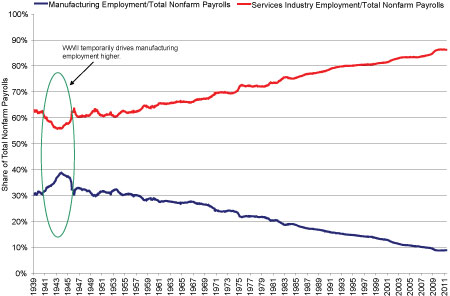Personal Wealth Management / Economics
Breaking News-US Manufacturing Isn’t Dead
US manufacturing is alive and well, making government claims there’s a need for a “national strategy” dubious at best.
Story Highlights:
- Many claim American manufacturing is in terminal decline—and has been.
- Politicians frequently use this as a means to propose legislation targeting votes.
- The only thing declining about American manufacturing is the payrolls, which is a trend extant for decades and is tied to productivity.
- One might bemoan that productivity, but it’s also the source of a healthy, globally competitive industry that’s the largest by manufacturing output in the world.
Opinions claiming American manufacturing has been in terminal decline for decades and is largely now a thing of the past are commonplace. (Here’s just one recent example.) And apparently, some of our wonderful friends in Congress agree with the general gist of the article.
In early April, HR 1366, the “National Manufacturing Strategy Act of 2011,” was drafted and now sits in committee, co-sponsored by 12 Republicans and 22 Democrats. This bill would require the president to create a manufacturing strategy board (yup, another government advisory board) comprised of the department heads of several government agencies (Treasury, Defense, Commerce, Labor, Energy, the US Trade Representative, Management and Budget and more). One can only imagine the pearls of industrial wisdom this panel—which would currently be comprised of four career government employees, two career politicians and an esteemed academic in the field of physics—would provide.
Don’t be mistaken: We at Fisher Investments MarketMinder are quite sure these fine folks have laudable achievements in their fields of expertise, but what exactly in their backgrounds qualifies them to dispense advice to manufacturing executives in charge of running an industry with over $1 trillion in annual output? And what exactly is the motivation for such a board? Or the problem this legislation seeks to address?
Data available—and ironically published by government agencies like the Bureau of Economic Analysis, Bureau of Labor Statistics and Federal Reserve—show this industry may not be in dire need of input or “strategizing” from government. While many in Congress opine US manufacturing is either dead, dying or on a quick road to irrelevance, the facts (again, produced by the government) just don’t support the assertions.
All the handwringing over the dire straits American manufacturing is supposedly in hinges on one metric: Manufacturing employment. But that’s perhaps not the best way to judge the liveliness of an industry, considering for the past hundred years (give or take), rising worker productivity has meant similar things to many industries (agriculture or desk clerks, for example. Typists. Retail clerks at record stores). In fact, manufacturing employment as a share of total US nonfarm payrolls has relatively consistently fallen for over half a century—aside from a brief blip up during WWII.
Manufacturing and Services Employment as a Share of Total Nonfarm Payrolls, 1939-2011.
Source: Federal Reserve Bank of St. Louis, Bureau of Labor Statistics.
That trend, in fact, is fully global—China has shed millions of manufacturing jobs since it began rapidly industrializing in the mid-1990s.
But while all the employment declines have occurred, American (and global) manufacturing output has grown by many orders of magnitude. In fact, US manufacturing output is the world’s biggest. US industry simply produces more with less labor—which frees said labor for productive uses elsewhere (like in the services industry—as shown in the graphic).
The US actually does have a strategy to promote manufacturing: It just happens to be decentralized and driven by experienced private-sector professionals. These folks plan for their own businesses, their own employees and themselves in the name of seeking profits. And that’s a strategy proven to work for generations.
While a legislative National Manufacturing Strategy may be politically palatable (pushing legislation seen as pro-jobs often equals getting votes), US manufacturing seems to be doing quite well without any such board overseeing its ongoing vibrancy. (In fact, government attempts to “help” often backfire.) The plain reality is the real cause of manufacturing employment’s decline is advancing productivity. That same force is the main reason US manufacturing is highly competitive globally.
If you would like to contact the editors responsible for this article, please message MarketMinder directly.
*The content contained in this article represents only the opinions and viewpoints of the Fisher Investments editorial staff.
Get a weekly roundup of our market insights
Sign up for our weekly e-mail newsletter.

See Our Investment Guides
The world of investing can seem like a giant maze. Fisher Investments has developed several informational and educational guides tackling a variety of investing topics.






